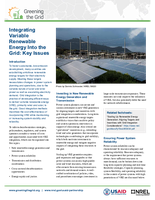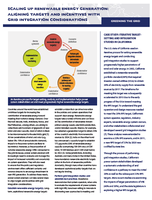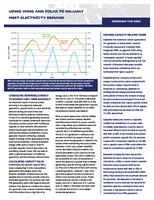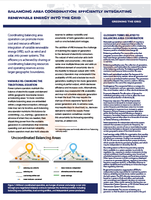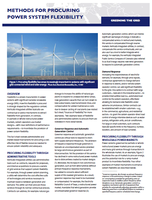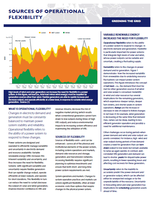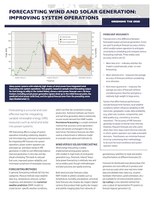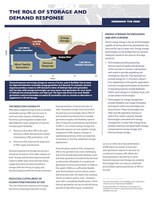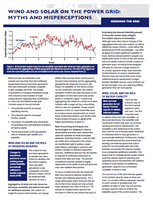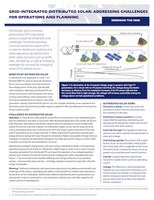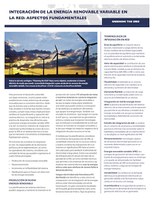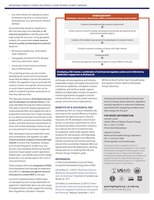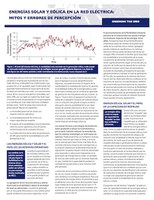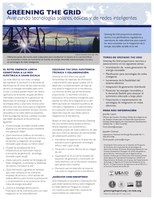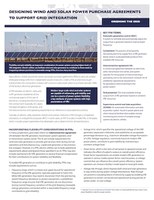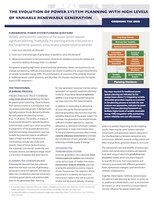Fact Sheets
Integrating Variable Renewable Energy Into the Grid: Key Issues
To foster sustainable, low-emission development, many countries are establishing ambitious renewable energy targets for their electricity supply. Because solar and wind tend to be more variable and uncertain than conventional sources, meeting these targets will involve changes to power system planning and operations. Grid integration is the practice of developing efficient ways to deliver variable renewable energy (VRE) to the grid. Good integration methods maximize the cost effectiveness of incorporating VRE into the power system while maintaining or increasing system stability and reliability.
Scaling Up Renewable Energy Generation: Aligning Targets and Incentives With Grid Integration Considerations
Countries around the world have established ambitious targets for increasing the contribution of renewable energy toward meeting their national energy demand. At low penetrations of wind and solar (e.g., below 5%–10% of annual electric demand), impacts to the power system are likely to be minimal. However, as the proportion of variable renewable energy (VRE) connected to the grid increases, power system planners will increasingly need to evaluate and manage the impact of increased variability and uncertainty on system operations. They will also need to ensure that the policy and regulatory environment offers sufficient certainty and revenue streams to encourage investment in new VRE generation. To address these needs, power system planners can take several steps to align targets and incentives with grid integration considerations.
Using Wind and Solar to Reliably Meet Electricity Demand
An important aspect of power system planning is ensuring that adequate generation capacity exists to meet electricity demand during all hours of the year. Mechanical failures, planned maintenance, or lack of on-demand generating resources (especially for variable renewable resources) may leave a power system with insufficient capacity to meet demand. Grid planners project future peak demand patterns and estimate the relative contribution of each generator towards achieving a reliable supply of energy. When generating during peak demand periods, variable renewable energy (VRE) such as wind or solar PV provides capacity value to the system. By providing capacity value, VRE can help to defer capital investments in traditional generation and transmission infrastructure.
Balancing Area Coordination: Efficiently Integrating Renewable Energy into the Grid
Coordinating balancing area operation can promote more cost and resource efficient integration of variable renewable energy (VRE), such as wind and solar, into power systems. This efficiency is achieved by sharing or coordinating balancing resources and operating reserves across larger geographic boundaries.
Grid Integration Studies: Data Requirements
A grid integration study is an analytical framework used to evaluate a power system with high penetration levels of variable renewable energy (VRE). A grid integration study simulates the operation of the power system under different VRE scenarios, identifying reliability constraints and evaluating the cost of actions to alleviate those constraints. These VRE scenarios establish where, how much, and over what timeframe to build generation and transmission capacity, ideally capturing the spatial diversity benefits of wind and solar resources. The results help build confidence among policymakers, system operators, and investors to move forward with plans to increase the amount of VRE on the grid. High quality data are critical to robust and reliable grid integration studies.
Greening the Grid Overview
This one-page fact sheet provides an introduction to the Greening the Grid project and summarizes program activities and offerings.
Methods for Procuring Power System Flexibility
This fact sheet reviews administrative and market-based mechanisms for procuring a cost effective mix of flexible resources needed to ensure system reliability and adequacy.
Sources of Operational Flexibility
Operational flexibility refers to the ability of a power system to respond to changes in electricity demand and generation. Flexibility is particularly important for power systems that integrate high levels of solar and wind, whose power outputs can be variable and uncertain, creating a fluctuating supply.
Forecasting Wind and Solar Generation
Forecasting is a crucial and cost- effective tool for integrating variable renewable energy (VRE) resources such as wind and solar into power systems.
The Role of Storage and Demand Response
Affordably integrating high levels of variable renewable energy (VRE) sources such as wind and solar requires a flexible grid. Storage and demand response provide means to better align wind and solar power supply with electricity demand patterns: storage shifts the timing of supply, and demand response shifts the timing of demand.
Wind and Solar on the Power Grid: Myths and Misperceptions
Wind and solar are inherently more variable and uncertain than the traditional dispatchable thermal and hydro generators that have historically provided a majority of grid-supplied electricity. The unique characteristics of variable renewable energy (VRE) resources have resulted in many misperceptions regarding their contribution to a low-cost and reliable power grid.
Grid-Integrated Distributed Solar: Addressing Challenges for Operations and Planning
Distributed, grid-connected photovoltaic (PV) solar power poses a unique set of benefits and challenges. This brief overviews common technical impacts of PV on electric distribution systems and utility operations (as distinct from other utility concerns such as tariffs, rates, and billing), as well as emerging strategies for successfully managing some of the priority issues.
Key Issues (Spanish)
Spanish-language Key Issues Fact Sheet
Forecasting (Spanish)
Spanish-language forecasting fact sheet
Renewable Energy Zones
REZ Fact Sheet
Myths (Spanish)
Spanish-language Myths Fact Sheet
GtG Overview (Spanish)
Spanish-language Greening the Grid Overview fact sheet
DESIGNING WIND AND SOLAR POWER PURCHASE AGREEMENTS TO SUPPORT GRID INTEGRATION
Power purchase agreements (PPAs) represent one of many institutional tools that power systems can use to improve grid services from variable renewable energy (VRE) generators. This fact sheet introduces the concept of PPAs for VRE generators and provides a brief summary of key PPA components that can facilitate VRE generators to enhance grid stability and serve as a source of power system flexibility.
The Evolution of Power System Planning with High Levels of Variable Renewable Generation
Power system planning methods and processes can evolve to address the unique characteristics of variable renewable energy (VRE). This brief presents an overview of the analyses involved in traditional power system planning, and describes the changes required to plan for higher levels of VRE integration.
Fact Sheets
Greening the Grid seeks to provide concise yet comprehensive information on important grid integration topics. Click the links below to download fact sheets overviewing these issues.
Hydrogen 101: Frequently Asked Questions About Hydrogen for Decarbonization
Hydrogen is emerging across the world as a potential low-carbon energy carrier that can provide an alternative to fossil fuels. With the increasing deployment of renewable energy, the role of low-carbon power generation in hydrogen production through electrolysis is expected to increase. Hydrogen can also play a role in reducing carbon emissions in several sectors such as chemicals, iron, steel, and long-haul transport like heavy-duty trucks and shipping. As a result of these possi- bilities, many countries have included hydrogen as a central part of their energy strategies.


